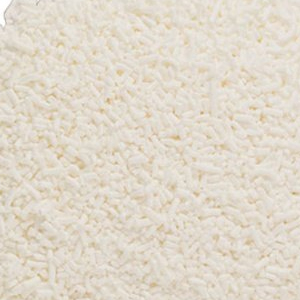
C6H7KO2 -- 150.22
2,4-Hexadienoic acid, (E,E)-, potassium salt; 2,4-Hexadienoic acid, potassium salt.
Potassium (E,E)-sorbate; Potassium sorbate [590-00-1; 24634-61-5].
Potassium Sorbate contains not less than 98.0 percent and not more than 101.0 percent of C6H7KO2, calculated on the dried basis.
Identification—
A: Dissolve 1 g in 10 mL of water: the solution responds to the test for Potassium.
B: Dissolve 0.2 g in 2 mL of water, and add a few drops of bromine: the color is discharged.
Acidity or alkalinity— Dissolve 1.1 g in 20 mL of water, and add PhPh. If the solution is colorless, titrate with 0.10 N sodium hydroxide to a pink color that persists for 15 seconds: not more than 1.1 mL is required. If the solution is pink in color, titrate with 0.10 N hydrochloric acid: not more than 0.80 mL is required to discharge the pink color.
Loss on drying— Dry it at 105C for 3 hours: it loses not more than 1.0% of its weight.
Heavy metals: 0.001%.
Assay— Dissolve about 300 mg of Potassium Sorbate, accurately weighed, in 40 mL of glacial acetic acid, warming, if necessary, to effect solution. Cool to room temperature, add 1 drop of crystal violet TS, and titrate with 0.1 N perchloric acid VS to a blue-green endpoint. Perform a blank determination, and make any necessary correction. Each mL of 0.1 N perchloric acid is equivalent to 15.02 mg of C6H7KO2.
C6H7KO2 --- 150.2 --- 590-00-1
Action and use:
Antimicrobial preservative.
DEFINITION
Potassium (E,E)-hexa-2,4-dienoate.
Content
99.0 per cent to 101.0 per cent (dried substance).
CHARACTERS
Appearance: White or almost white powder or granules.
Solubility: Very soluble in water, slightly soluble in ethanol (96 per cent).
IDENTIFICATION
First identification: B, D.
Second identification: A, C, D.
A. Ultraviolet and visible absorption spectrophotometry.
Test solution: Dissolve 50.0 mg in water R and dilute to 250.0 ml with the same solvent.
Dilute 2.0 ml of this solution to 200.0 ml with 0.1 M hydrochloric acid.
Spectral range: 230-350 nm.
Absorption maximum: At 264 nm.
Specific absorbance at the absorption maximum: 1650 to 1900.
B. Infrared absorption spectrophotometry.
Comparison potassium sorbate CRS.
C. Dissolve 1.0 g in 50 ml of water R, add 10 ml of dilute hydrochloric acid R and shake.
Filter the crystalline precipitate, wash with water R and dry in vacuum over sulphuric acid R for 4 h. The residue obtained melts at 132C to 136C.
D. Dissolve 0.2 g in 2 ml of water R and add 2 ml of dilute acetic acid R. Filter. The solution gives reaction (b) of potassium.
TESTS
Solution S: Dissolve 2.5 g in carbon dioxide-free water R and dilute to 50 ml with the same solvent.
Appearance of solution: Solution S is clear and not more intensely coloured than reference solution.
Acidity or alkalinity: To 20 ml of solution S add 0.1 ml of PhPh solution R. Not more than 0.25 ml of 0.1M sodium hydroxide or 0.1 M hydrochloric acid is required to change the colour of the indicator.
Aldehydes: Maximum 0.15 per cent, expressed as C2H4O.
Dissolve 1.0 g in a mixture of 30 ml of water R and 50 ml of 2-propanol R, adjust to pH 4 with 1 M hydrochloric acid and dilute to 100 ml with water R. To 10 ml of the solution add 1 ml of decolorised fuchsin solution R and allow to stand for 30 min. Any colour in the solution is not more intense than that in a standard prepared at the same time by adding 1 ml of decolorised fuchsin solution R to a mixture of 1.5 ml of acetaldehyde standard solution (100 ppm C2H4O) R, 4 ml of 2-propanol R and 4.5 ml of water R.
Heavy metals: Maximum 10 ppm.
2.0 g complies with test D. Prepare the reference solution using 2 ml of lead standard solution (10 ppm Pb) R.
Loss on drying: Maximum 1.0 per cent, determined on 1.000 g by drying in an oven at 105 °C for 3 h.
Potassium Sorbate IP Grade is also offered.
2,4-Hexadienoic Acid, Potassium Salt
CH3CH CHCH CHCOOK
C6H7KO2 Formula wt 150.22
CAS: [590-00-1]
DESCRIPTION
Potassium Sorbate occurs as white to off white crystals, crystalline powder, or pellets. It decomposes at about 270C.
REQUIREMENTS
Identification:
A. A 1:10 aqueous solution responds to the flame test for Potassium.
B. Add a few drops of bromine TS to 2 mL of a 1:10 solution. The color disappears.
Assay: Not less than 98.0% and not more than 101.0% of C6H7KO2, calculated on the dried basis.
Acidity (as sorbic acid): Passes test (about 1%).
Alkalinity (as K2CO3): Passes test (about 1%).
Lead: Not more than 2 mg/kg.
Loss on Drying: Not more than 1.0%.